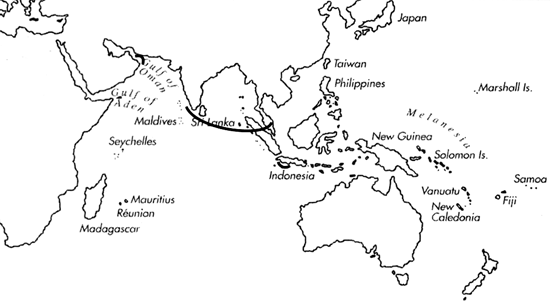Range: India and Sri Lanka to W. Thailand; probably also Gulf of Oman.
Description: Medium-sized to large, moderately solid to heavy. Last whorl conical, outline variably convex at adapical fourth to third and straight below. Shoulder angulate to carinate. Spire of low to moderate height, outline deeply concave with a projecting conical apex of 5-7 postnuclear whorls. Maximum diameter of larval shell about 0.9 mm. First 7-9 postnuclear whorls tuberculate. Teleoconch sutural ramps flat to concave, with obsolete spiral striae. Last whorl with weak to obsolete spiral ribs at base.
| Shell Morphometry | ||
|---|---|---|
| L | 45-95 mm | |
| RW | 0.23-1.15 g/mm | |
| RD | 0.50-0.61 | |
| PMD | 0.85-0.90 | |
| RSH | 0.07-0.14 | |
Ground colour white or cream. Last whorl suffused or spirally banded with pale orange or pink. Spiral rows of brown dots, dashes and variously shaped spots extend from base to shoulder but vary in number and arrangement, often concentrated at both sides of centre. Sometimes dark markings fuse into axial flames or blotches. Base pale orange or brown. Larval whorls greyish beige. Early postnuclear sutural ramps immaculate; late ramps with a varying number of brown radial markings. Aperture white.
Periostracum yellowish brown to olive-brown, rather thin, translucent to opaque, smooth or with fine axial ridges
Habitat and Habits: Intertidal to about 20 m; on sand bottom with patches of clay and shell rubble (India; Kohn, 1978a).
Discussion: C. monile is similar in shape and sculpture to C. capreolus, C. bayani, C. generalis and C. maldivus. C. capreolus is easily distinguished by the confluent, fawn axial streaks on its last whorl. C. bayani has a lighter shell with a white base and usually lacks pink bands; brown spiral bands overly its axial pattern elements and the larval whorls are brown. C. generalis has a taller, projecting apex, fewer tuberculate postnuclear whorls, a violet to black base and a pattern of spiral colour bands overlying axial elements that extend over the entire last whorl. C. maldivus has a dark brown to violet-brown base and its pattern consists of continuous to highly divided brown spiral bands with axial extensions into adjacent ground-colour zones.

C. monile range map
This section contains verbatim reproductions of the accounts of 316 species of Conus from the Indo-Pacific region, from Manual of the Living Conidae, by Röckel, Korn and Kohn (1995). They are reproduced with the kind permission of the present publisher, Conchbooks.
All plates and figures referred to in the text are also in Röckel, Korn & Kohn, 1995. Manual of the Living Conidae Vol. 1: Indo-Pacific Region.
The range maps have been modified so that each species account has it own map, rather than one map that showed the ranges of several species in the original work. This was necessary because each species account is on a separate page on the website and not confined to the order of accounts in the book.